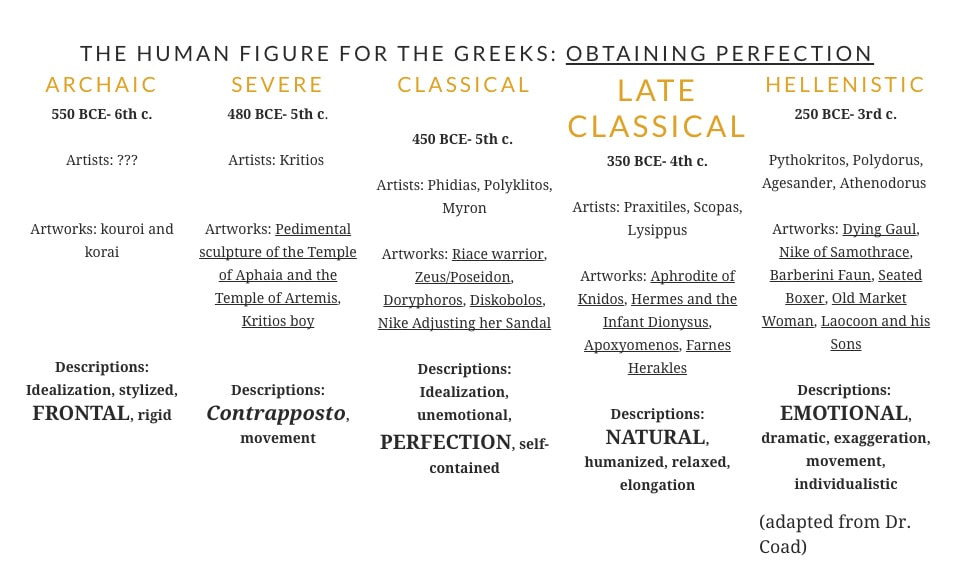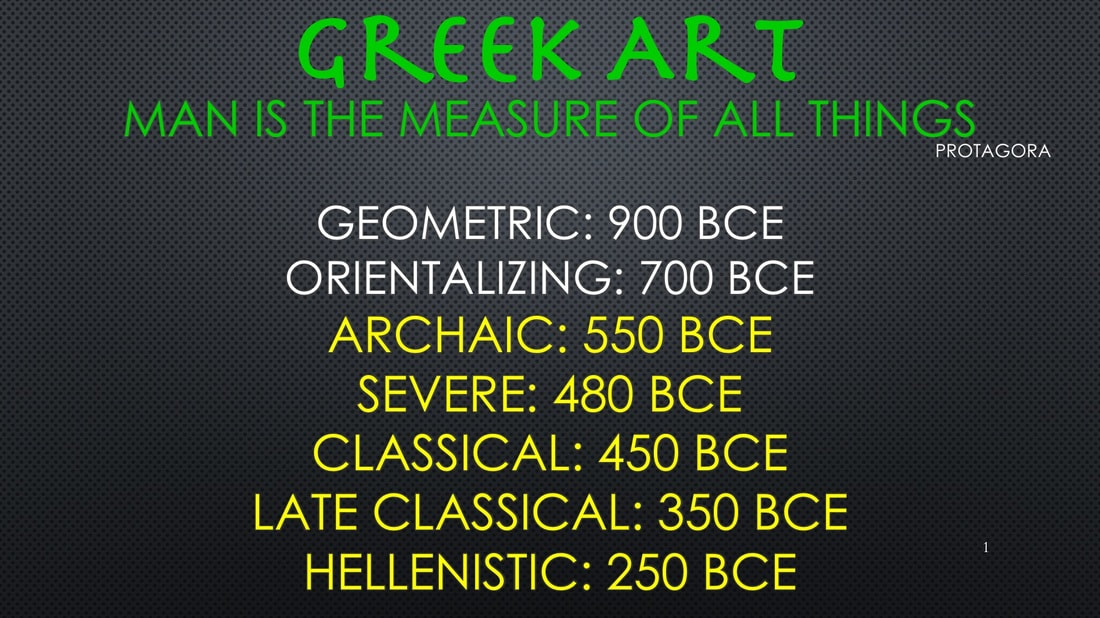KEY IDEAS
• There was an emphasis on self-knowledge and moderation (sophrosyne) as opposed to arrogant pride and excess (hubris).
• The Greek concept of aesthetics (appreciation of beauty) was based on mathematical proportions and the concept of “man” as the “measure of all things.”
• The Greeks valued a balance between intellect and feeling (worship of both Apollo and Dionysos is applicable here).
- Greeks are interested in the human figure the idea of perfection.
- Greek Temples provide a foundation for European architecture and reflects the idea of obtaining perfection with mathematical ratios.
- The Greek time period starts at around 900 BCE, about 200 years after the collapse of the Mycenaeans.
- In the 5th century, the Greeks defeated the Persians, though it left Athens in ruins (rebuilt by Pericles) = Start of the Classical time period
- Polykleitos's canon of proportions: The head should be 1/7 of the body. The chiastic stance that expresses the alternating relaxed and stressed muscles.
- The Peloponnesian War in 432 BCE (lasted about 27 years) devastated and crushed Athens by the victorious Spartans = Start of the Hellenistic
- Alexander the Great took over and united the Macedonians with the Greeks in the 4th century and after his death, his empire gave into Roman rule.
• There was an emphasis on self-knowledge and moderation (sophrosyne) as opposed to arrogant pride and excess (hubris).
• The Greek concept of aesthetics (appreciation of beauty) was based on mathematical proportions and the concept of “man” as the “measure of all things.”
• The Greeks valued a balance between intellect and feeling (worship of both Apollo and Dionysos is applicable here).
|
ARTWORK LIST
SCULPTURE GEOMETRIC GEOMETRIC (FUNERARY) KRATER ARCHAIC ANAVAYOS KOUROS PEPLOS KORE SEVERE KRITIOS BOY NIOBIDES KRATER CLASSICAL DORYPHOROS RIACE WARRIOR DISKOBOLOS LATE CLASSICAL HELIOS, HORSES AND DIONYSUS PLAQUE OF THE ERGASTINES VICTORY ADJUSTING HER SANDAL GRAVE STELE HELLENISTIC NIKE OF SAMOTHRACE ATHENA FROM THE PERGAMON ALTAR SEATED BOXER OLD MARKET WOMAN |
ARCHITECTURE
PARTHENON ALTAR OF ZEUS AT PERGAMON GREEK PAINTING
ALEXANDER MOSAIC FROM THE HOUSE OF FAUN |
VOCABULARY
ACROPOLIS
ARCHITRAVE
ATHENA
CANON
CARYATID
CELLA
CHIASTIC
CONTRAPPOSTO
DORIC
ENCAUSTIC
ENTABLATURE
FRIEZE
GIGANTOMACHY
IONIC
KOUROS
KORE
KRATER
LOST WAX PROCESS
METOPE
NIKE
OPISTHODOMOS
PANATHENAIC PROCESSION
PEDIMENT
PEPLOS
PERIPTERAL
PERISTYLE
PROPYLAEA
SHAFT
STELE
TRIGLYPH
VOLUTE
ZEUS
ACROPOLIS
ARCHITRAVE
ATHENA
CANON
CARYATID
CELLA
CHIASTIC
CONTRAPPOSTO
DORIC
ENCAUSTIC
ENTABLATURE
FRIEZE
GIGANTOMACHY
IONIC
KOUROS
KORE
KRATER
LOST WAX PROCESS
METOPE
NIKE
OPISTHODOMOS
PANATHENAIC PROCESSION
PEDIMENT
PEPLOS
PERIPTERAL
PERISTYLE
PROPYLAEA
SHAFT
STELE
TRIGLYPH
VOLUTE
ZEUS



